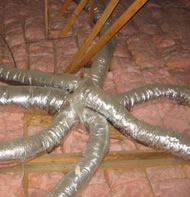|
Heating and Cooling Systems Custom Search The heating and cooling systems of your home are also known as its HVAC equipment. This acronym stands for Heating, Ventilation & Air Conditioning. The HVAC equipment is responsible for the temperature, humidity & quality of the indoor environment and comfort for the habitants. There are many different types of heating, ventilating & cooling equipment. The type of equipment used in any particular area has to with its climate. The length & coldness of winter and the length & hotness of summer are the main factors in determining what is needed. The humidity levels also play an important role on what equipment would be required.
HEATING SYSTEMS Heating your home obviously is a process of adding heat to the indoor environment therefore increasing the temperature. The typical winter time thermostat temperature setting is 66F to 70F with the average being around 68F. This is a reasonable temp for comfort and efficiency. Below are the most common heating systems installed in new homes today.
Heat Pump – There are several types of heat pumps, however most common is the air-source heat pump. Heat pumps provide the heating and cooling for your home. Hydronic – Water is heated by a boiler and circulated through radiators located in the home. Radiant – Water is heated by a boiler and circulated through tubing located in floors, walls or ceilings to warm those surfaces which in turns heats the space by radiation.
Electric – Heat is supplied through electric or resistance heaters when electricity is passed through the device.
COOLING SYSTEMS The cooling of your home, also known as air conditioning, is the removal of heat to cool and dehumidify the indoor air. The typical summer time thermostat setting is 74F to 80F with the average being around 78F. This average temperature is reasonable for comfort and efficiency. Below are the most common A/C systems installed in new homes today. Forced Air – Most common type of heating and cooling systems installed. A compressor circulates a refrigerant between two coils (one indoors & one outdoors), then a blower blows through the indoor coil which removes the heat from the home and then it is circulated to the exterior to dissipate the heat that was absorbed to the outdoor air. It uses a system of ductwork to distribute the conditioned air throughout the home. Ductless Split System – A mini-split air conditioning system. Similar to the traditional split system, however each room has a air handler located it for individual control and therefore no need for ductwork.
VENTILATION The purpose of ventilation in a home is to help control the indoor air quality & humidity levels. It is best to control this ventilation through the heating and cooling systems of the home. Kitchens and bathrooms have ventilation systems for removal of odors and moisture. If these are ducted through unconditioned areas (ex: attic, crawlspace), they should be insulated to prevent condensation from forming. Clothes dryers are another form of ventilation where the moisture is vented to the exterior. This ducting should be made of metal pipe for proper fire protection and its joints are to be only taped together (high quality aluminum tape is best) as screws will collect lint & eventually clog the duct. Clothes dryers should NEVER be vented to the interior (some stores sell this type of lint collector for this purpose) as this will increase the indoor humidity levels tremendously and will contribute to mold growth & poor indoor air quality. Today’s homes are being built much tighter therefore allowing less infiltration of outdoor air. The air exchange rate (outdoor air that leaks into the home) of newer homes is much lower than older homes, therefore the indoor air can become stagnant and unhealthy if nothing is done to increase this air exchange rate. Most home heating and cooling units, including forced air heating systems, do NOT mechanically bring fresh air into the house. One way of doing this is with a heat recovery ventilator. This device brings in outdoor air through a type of exchanger where the indoor also passes through it, therefore transferring the heat from the indoor air into the outdoor air that is being brought into the home. You can also installed a duct on your HVAC return plenum directly from the outdoors so that any time your home is under negative pressure, it draws the air through this duct instead of through the cracks in your home.
|
Building Tip
"Insist your HVAC ductwork be professionally designed. A properly designed system will be more energy efficient since you will be able to use smaller equipment and the home will be more comfortable."

The above picture is an example of a poorly designed duct system and it will not distribute the air properly to the interior rooms.
INSPIRING THOUGHT
“Only those who attempt the absurd can achieve the impossible.”
~ Albert Einstein
